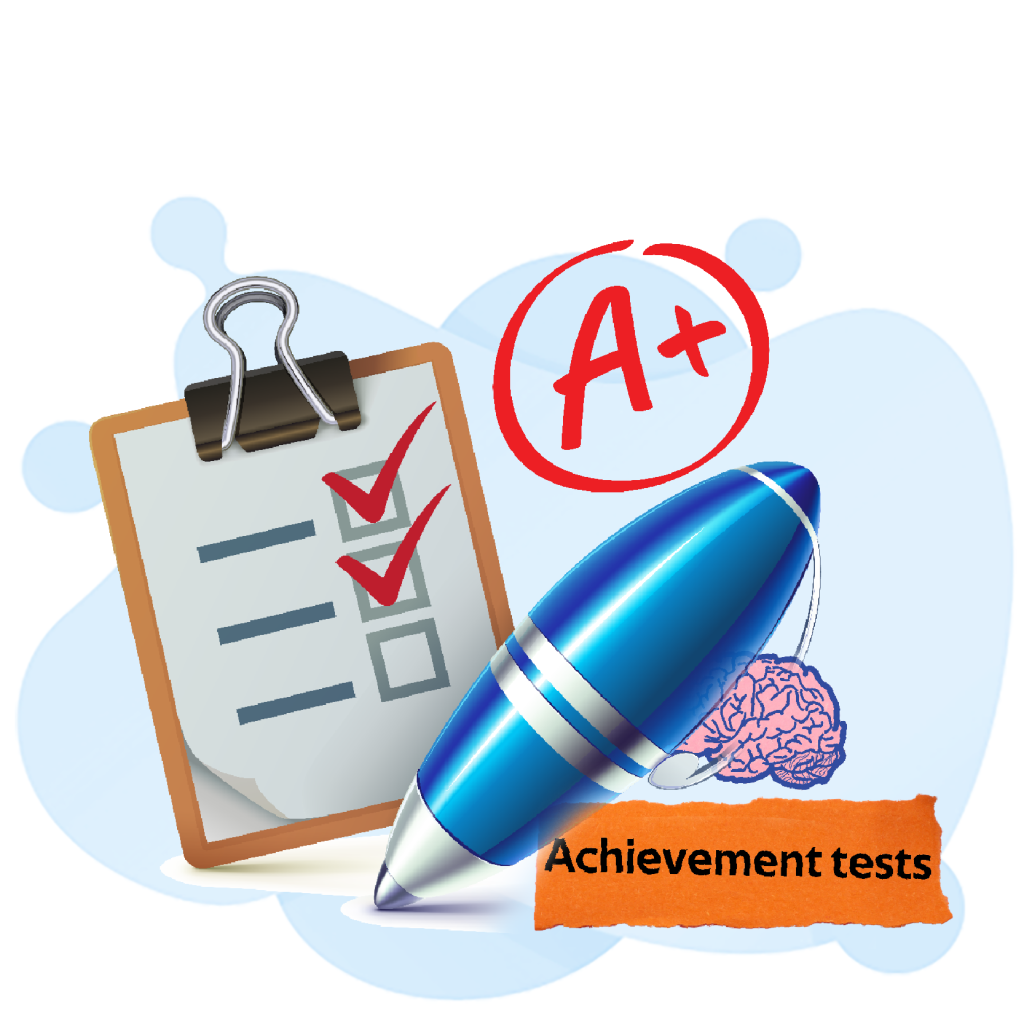Standardized Achievement Test

Achievement tests are standardized norm-referenced assessments that measure the examinee’s level of knowledge and skill. They can be administered individually or as a group. A good test must be objective and free of personal errors and biases.
A high score on an achievement test indicates that the examinee has mastered a grade-level topic and is ready to move on. However, low scores can indicate that the examinee is not ready for advancement or should receive additional training.
FREE Standardized Achievement Test Online
California Achievement Test
The California Achievement Test (CAT) is one of the most widely used standardized tests for children in kindergarten through grade 12. It is often used to determine whether a child should advance to a higher grade level and is also used by schools as part of state testing programs. The CAT is often administered to students in grades 3 through 7 as part of the STAR program.
Depending on the subject, the CAT is normed by comparing a student’s score to that of students in a nationally representative group. The resulting scores may be reported as either a scale score or percentile. A percentile measurement indicates how many students scored lower than the student on the assessment. Scale scores may be calculated in different ways, such as through item-pattern scoring, which examines the pattern of questions answered correctly and their difficulty levels.
While the CAT is commonly associated with traditional schooling, it is frequently used by homeschoolers as a way to assess their children’s progress. Homeschooling families must by law administer a nationally standardized test to each student annually, until they graduate high school.
Peabody Individual Achievement Test
The Peabody Individual Achievement Test is a criterion-based survey of an individual’s scholastic attainment. It can be administered to pupils and students between the ages of five and 22. The test evaluates their academic abilities in the areas of general information, reading recognition, reading comprehension, mathematics and spelling. It also assesses their written subject area, which includes two categories of language abilities: pre-writing skills and crafting a story about a picture.
The PIAT-R/NU is normed on a carefully stratified sample and has substantial support for reliability and validity. It is easy to administer, and the derived scores indicate grade level equivalents and percentile rankings. It can be used by clinical psychologists, counselors, and learning specialists. It is also an excellent tool for identifying learning disabilities. The PIAT is an oral assessment and is normed at any point in the year, which means that it can be used to test students from kindergarten through high school. It can be used to determine the student’s strengths and weaknesses, which is critical for learning disability identification.

Stanford Achievement Test
The Stanford Achievement Test is a nationally normed standardized assessment that helps home educators get information about their students’ performance and provides comparisons based on nationwide test results. The test is designed for grades K through 12, and meets many state testing requirements, including New York.
The SAT10 includes a variety of subject-specific subtests that measure your child’s knowledge and skills. For example, the reading comprehension section measures the student’s ability to read selections from children’s literature and answer questions based on those passages. It also measures the skills of understanding, interpretation, critical analysis, and reading strategies.
The SAT10 provides two types of score reports: the national percentile rank (PR) and the stanine score. The PR tells you how your child’s performance compares to other students in the nation, while the stanine organizes children into nine categories based on their scores. The higher the stanine, the better your child’s performance is. The stanine score identifies the range in which your child performs, with one representing below average performance and nine above average.
Wechsler Individual Achievement Test
The Wechsler Individual Achievement Test (WIAT) is a comprehensive individually administered assessment that measures academic abilities. The WIAT is often used to assess students with learning disabilities and to identify giftedness. It measures verbal, reading, and mathematical skills and consists of 16 subtests. Each of these subtests contributes to a different domain score.

The WIAT’s first subtest, Oral Language, measures the ability to listen and understand information presented orally. It also tests a person’s vocabulary and grammar. The second test is Reading Comprehension and Basic Reading, which measure a person’s ability to read passages and understand them. The third test is Word Reading, which measures a person’s ability to decode and pronounce single-word words. Poor performance on this test could suggest dyslexia.
The WIAT is a commercially available standardized test that produces subtest and cluster or composite standard scores in the form of percentile ranks, stanines, and normal curve equivalent scores. It also yields a total achievement index in the form of FSIQ. Convergent validity between the WIAT and Woodcock-Johnson III Tests of Achievement – Form A is established in both normative and clinical samples.
Woodcock Johnson Test of Achievement
The Woodcock-Johnson IV (WJ IV) is the newest version of one of the most widely used batteries of individually administered psycho-educational tests. It is based on the latest evolution of Cattell-Horn-Carroll (CHC) theory and has been designed to provide greater breadth than previously available. The new test suite consists of independent, co-normed assessments of academic achievement, oral language and cognitive abilities.
The WJ IV COG provides a comprehensive assessment of the broad and narrow cognitive abilities defined by CHC theory of intelligence. The co-normed battery offers examiners the ability to identify specific referral questions and evaluate strengths and weaknesses within and among measures of academic achievement, oral language and cognitive abilities.
Errors are common with administration and scoring of normed test instruments. This study examined eighty Woodcock-Johnson IV protocols from 40 examiners and found that non-critical errors were present on all protocols, while critical error rates were higher for tests of academic achievement. The findings add to the growing body of literature on errors in normed test administration and scoring.

Kaufman Test of Educational Achievement
In the classroom, students are often exposed to a variety of assessments. These can be formal standardized tests or informal teacher-made ones. The purpose of these assessments is to measure a student’s mastery of content, skill and general academic knowledge. While there are many strengths associated with standardized measures, it is important to understand that not all standardized assessments are accurate. Some tests are not able to accurately assess the performance of students who do not have access to new information due to lack of exposure at school or at home.
The Kaufman Tests of Educational Achievement – Third Edition (KTEA-3), is a standardized assessment that measures literacy skills, math concepts and abilities and written expression. The KTEA-3 is available in two forms, the comprehensive form and the brief form. The comprehensive form takes about a half hour to administer and covers letter and word recognition, math computation, reading comprehension and writing expression. The brief form is less in-depth and takes about 15 minutes to administer. A sample report template is included that can be used for this assessment.
Achievement Test Psychology Definition
Achievement tests are used in many settings, but are most commonly found in educational environments. These tests are used to measure a student’s level of knowledge and skill in a subject. They can be standardized or informal, and they can be administered in a group or one-on-one setting.

Unlike aptitude tests, which focus on an individual’s innate abilities, achievement tests emphasize abilities that have been acquired through formal learning and training. They are a way for teachers and professionals to see how much a student has learned, and can help determine whether a student is ready for the next level of education or training.
These tests are often criticized by those who argue that they are harmful to students’ development and place too much emphasis on test results. However, there are ways to improve the quality of these tests. For example, a good achievement test should have high objectivity and be free from personal bias. It should also be easy to interpret for the examinee and should not contain any misleading information.
Wide Range Achievement Test
The Wide Range Achievement Test is a norm-referenced test that measures fundamental reading, spelling and math skills. It consists of four subtests: Word Reading, Sentence Comprehension, Spelling, and Maths Computation. It is easy to administer and takes 15-25 minutes for children ages five and seven, and 35-45 minutes for individuals aged eight and up.
It is commonly used to screen for possible learning disabilities. It is also useful for evaluating people with cognitive impairments. It is a quick and efficient way to assess an individual’s progress, and its results can be compared with the results of other psychological tests.
Its high correlation with full scale IQ of WAIS-R means that it is a very reliable measure of an individual’s intelligence. It also correlates moderately with other IQ tests, including the Peabody Individual Achievement Test and the Stanford–Binet. This is important because it allows for a more comprehensive evaluation of the patient’s intelligence and academic performance. This makes it ideal for use by clinicians in clinical and education settings.
Achievement Test Questions and Answers
The student success percentage at Achieve Test Prep is stated to be around 93%.
A test of developed skill or knowledge is an achievement test. The most popular kind of accomplishment test is a standard assessment designed to gauge the skills and knowledge acquired in a particular grade level, typically through scheduled teaching, like training or classroom instruction.
No, Achieve is not a college and neither does it have accreditation.
• University of Kentucky
• University of South Florida
• Baylor University
• University of Texas
• Arizona State University
• Miami University
• University of Houston
It evaluates the abilities and information acquired at a specific grade level.
Five versions of LevelSet are available from Achieve3000 in both English and Spanish. 30 questions are on each edition.
Yes. One of the most popular and well-liked national accomplishment assessments is the California Achievement Test.
Live instructors who are specialists in their industry teach test prep classes.
It takes about 2 1/2 hours.
Generally speaking, you should budget anywhere between $40,000 and $80,000.
A stanine of 1, 2, or 3 often denotes performance that is below average. A stanine of 4, 5, or 6 denotes modest success, while 7, 8, or 9 denotes above average.
The average percentile score is 50, with scores ranging from 1 to 99. Stanine Scores range from 1 to 9, with 5 representing the average.
You must receive at least a 70% on this exam to pass it with Delta.
1 – Lowest level
2 – Low level
3 – Well below average
4 – Slightly below average
5 – Average
6 – Slightly above average
7 – Well above average
8 – High level
9 – Highest level
- 69 and below – Very Low
- 70 to 79 – Low
- 80 to 89 – Low Average
- 90 to 110 – Average
- 111 to 120 – High Average
- 121 to 130 – Superior
- 131 and above – Very Superior
The answer is no, Achieve is not accredited.
Yes, almost any college or university can use Achieve’s curriculum.
For people who require extra assistance with greater learning, Achieve Test Prep is a good program.
The SAT is mostly an aptitude test.
The WAIS (Wechsler Adult Intelligence Scale) is an aptitude test.
A standardized exam, like the SAT, which is necessary for admission to colleges in the United States, is the most typical type of achievement test.
Any assessment procedure or tool used to estimate a test taker’s level of mastery of particular knowledge or abilities is known as an achievement test.
• The SAT and ACT tests.
• An examination for your social psychology course.
• A math test covering the most recent section of your book.
• An example of a skill in your martial arts lesson.
• A thorough final in Spanish class.
The majority of achievement tests have been divided as group- or individually administered tests, single-subject tests, survey batteries, or diagnostic tests.
The Stanford GE occasionally includes PHS, or Post High School.
The 22-section Woodcock Johnson III and Woodcock Johnson IV Tests of Achievement measure academic achievement (what students have learned in school) as well as cognitive development.
Stanine Scores vary from 1 to 9, with 9 being the highest.
When an exam is given, scored, and evaluated uniformly among all test takers, it is said to be “standardized.”
Students in Grades 3, 6, 10, and 12 in the Philippines take the National Achievement Test, a set of uniform exams. The test is intended to assess the students’ academic standing, academic strengths and shortcomings, and their mastery of the year’s core courses.
Although it is based on an equal interval scale, the normal curve equivalent (NCE) is a norm-referenced score that resembles percentile rank. This implies that the NCE scale’s difference between any pair of subsequent values has the same significance across the scale.
An exam that evaluates a person’s linguistic, mathematical, and subject-area proficiency.
While achievement exams concentrate on what has already been taught, aptitude tests concentrate on a person’s capacity to learn new things.
Six separate examinations make up this evaluation, which tracks each student’s academic progress. Its multiple-choice structure permits a pointing response for the majority of the items, and it can be used to identify particular learning difficulties.
To evaluate one’s knowledge and abilities.
The second edition of the Wechsler Individual Achievement Test measures academic achievement in adults and children between the ages of 4 and 85. The test allows for the evaluation of a wide range of academic skills or only a specific area of need.
The Wide Range Achievement Test, now in its fifth edition, assesses a person’s aptitude for reading words, understanding sentences, spelling, and calculating answers to mathematical problems. People from the age of five up to adults can take the test.
Good intelligence tests exhibit construct validity, which means that they truly measure intelligence rather than something else, and reliability, which means that they are consistent over time.
The publishing company Harcourt produces it (now owned by Pearson).
• Creating a test plan
• Creating a test design
• Drawing out the blueprint
• Creating an initial draft
• Composing the last draft
• Implementation of Standardization
In the Australian state of Victoria, the General Achievement Test is a test of general knowledge and abilities covering communication, mathematics, science and technology, the arts, humanities, and social sciences.
• Power Test
• Prognostic Test
• Speed Test
• Diagnostic Test
• Accuracy Test
Students in Grades 3, 6, 10, and 12 take the National Achievement Test (NAT), a standardized collection of tests, in the Philippines.
In order to help with placement decisions for the English Speakers of Other Languages (ESOL) program, non-native English speakers who lack norm referenced exam scores are given the Metropolitan Achievement Test, a norm-referenced achievement test.
Achievement tests offer thorough information on students’ academic performance and help with curriculum creation and adaption so that they are more relevant and appropriate for students. It aids in addressing the issues and enhancing the various educational systems.